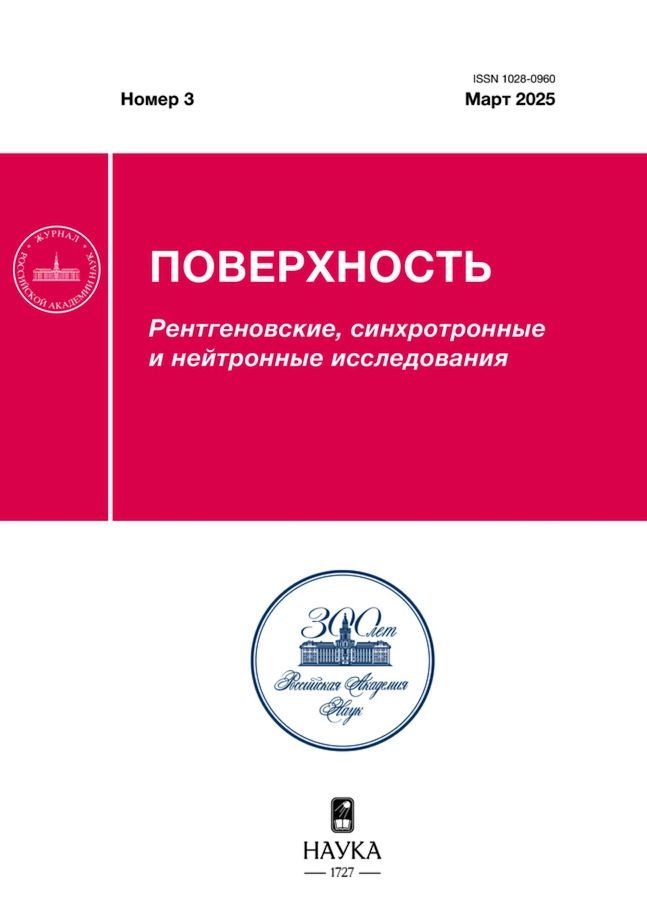Modification of bentonite properties with iron oxide nanoparticles
- Authors: Noskov A.V.1, Alekseeva O.V.1, Yashkova D.N.1, Agafonov A.V.1, Shipko M.N.2, Stepovich M.A.3, Savchenko E.S.4
-
Affiliations:
- Krestov Institute of Solution Chemistry RAS
- Lenin Ivanovo State University of Power Engineering
- Tsiolkovsky Kaluga State University
- National University of Science and Technology “MISiS”
- Issue: No 3 (2025)
- Pages: 30-38
- Section: Articles
- URL: https://j-morphology.com/1028-0960/article/view/687549
- DOI: https://doi.org/10.31857/S1028096025030055
- EDN: https://elibrary.ru/EKVTZQ
- ID: 687549
Cite item
Abstract
Powdered materials based on bentonite and a mixed solid solution magnetite/maghemite were synthesized by the chemical coprecipitation method. Scanning electron microscopy, X-ray phase analysis, magnetic measurements, and nuclear γ-resonance spectroscopy were used to characterize the surface and study the physicochemical properties of the resulting compounds. It has been found that bentonite affects the point defects in the magnetite/maghemite crystal lattice, as well as the crystallite size and dislocation density. It has been shown that samples of the bentonite/iron oxide composite are characterized by lower residual magnetization and higher values of the effective anisotropy field strength compared to those detected for Fe3O4/γ-Fe2O3 powder. Based on the Mössbauer spectroscopy data, a conclusion has been made about the localization of Fe2+ ions in the bentonite structure near oxygen vacancies that form octahedral positions.
Full Text
About the authors
A. V. Noskov
Krestov Institute of Solution Chemistry RAS
Author for correspondence.
Email: avn@isc-ras.ru
Russian Federation, Ivanovo
O. V. Alekseeva
Krestov Institute of Solution Chemistry RAS
Email: avn@isc-ras.ru
Russian Federation, Ivanovo
D. N. Yashkova
Krestov Institute of Solution Chemistry RAS
Email: avn@isc-ras.ru
Russian Federation, Ivanovo
A. V. Agafonov
Krestov Institute of Solution Chemistry RAS
Email: avn@isc-ras.ru
Russian Federation, Ivanovo
M. N. Shipko
Lenin Ivanovo State University of Power Engineering
Email: avn@isc-ras.ru
Russian Federation, Ivanovo
M. A. Stepovich
Tsiolkovsky Kaluga State University
Email: avn@isc-ras.ru
Russian Federation, Kaluga
E. S. Savchenko
National University of Science and Technology “MISiS”
Email: avn@isc-ras.ru
Russian Federation, Moscow
References
- Awad A.M., Shaikh S.M.R., Jalab R., Gulied M.H., Nasser M.S., Benamor A., Adham S. // Sep. Purif. Technol. 2019. V. 228. P. 115719. https://doi.org/10.1016/j.seppur.2019.115719
- Huilin Z., Xiaoyu L., Chao Y., Niu C., Wang J., Xintai Su X. // J. Alloys Compd. 2016. V. 688. P. https://1019. doi.org/10.1016/j.jallcom.2016.07.036
- Кафеева Д.А., Куршанов Д.А., Дубовик А.Ю. // Изв. РАН. Сер. физ. 2023. T. 87. № 6. C. 801. https://doi.org/10.31857/S0367676523701399
- Магомедов К.Э., Омельянчик А.С., Воронцов С.А., Чижмар Э., Родионова В.В., Левада Е.В. // Изв. РАН. Сер. физ. 2023. т. 87. № 6. с. 819. https://doi.org/10.31857/S0367676523701429
- Шипко М.Н., Cтепович М.А., Носков А.В., Алексеева О.В., Смирнова Д.Н. // Изв. РАН. Сер. физ. 2022. Т. 86. № 9. С. 1222. https://doi.org/10.31857/S0367676522090289
- Алексеева О.В., Шипко М.Н., Смирнова Д.Н., Носков А.В., Агафонов А.В., Степович М.А. // Поверхность. Рентген. синхротр. и нейтрон. исслед. 2022. №3. С. 23. https://doi.org/10.31857/S1028096022030025
- Bakandritsos A., Simopoulos A., Petridis D. // Nanotechnology. 2006. V. 17. № 4. P. 1112. https://doi.org/10.1088/0957-4484/17/4/044
- Сапаргалиев Е.М. // Изв. НАН Респ. Казахстан. Геология Казахстана. 2003. № 3. С. 64.
- Carriazo J.G., Centeno M.A., Odriozola J.A., Moreno S., Molina R. // Appl. Catal. A. Gen. 2007. V. 317. № 1. P. 120. https://doi.org/10.1016/j.apcata.2006.10.009
- Tireli A.A., Guimarães I.R., Terra J.C.S, da Silva R.R., Guerreiro M.C. // Environ. Sci. Pollut. Res. 2015. V. 22. P. 870. https://doi.org/10.1007/s11356-014-2973-x
- Алексеева О.В., Смирнова Д.Н., Носков А.В., Кузнецов О.Ю., Кириленко М.А., Агафонов А.В. // Журн. неорган. химии. 2023. Т. 68. № 8. С. 1021. https://doi.org/10.31857/S0044457X23600299
- Yan L., Li S., Yu H., Shan R., Du B., Liu T. // Powder Technol. 2016. V. 301. P. 632. https://doi.org/10.1016/j.powtec.2016.06.051
- Курмангажи Г., Тажибаева С.М., Мусабеков К.Б., Левин И.С., Кузин М.С., Ермакова Л.Э., Ю В.К. // Коллоидн. журн. 2021. Т. 83. № 3. С. 320. https://doi.org/10.31857/S0023291221030095
- Annamária M., Zuzana O., Jirí S. // J. Hazard. Mater. 2010. V. 180. № 1–3. P. 274. https://doi.org/10.1016/j.jhazmat.2010.04.027
- Nirmla D., Joydeep D. // Int. J. Biol. Macromol. 2017. V. 104. P. 1897. https://doi.org/10.1016/j.ijbiomac.2017.02.080
- Лыгина Т.З., Сабитов А.А., Трофимова Ф.А. Бентониты и бентонитоподобные глины: классификация, особенности состава, физико-химические и технологические свойства. Казань: ЦНИИгелнеруд, 2005. 72 с.
- Архипов Р.В., Гизатуллин Б.И., Дулов Е.Н., Ивойлов Н.Г. // Вестн. Казан. технол. ун-та. 2011. № 10. С. 79.
- Шилова О.А., Николаевa А.М., Коваленко А.С., Синельников А.А., Копица Г.П., Баранчиков А.Е. // Журн. неорган. химии. 2020. Т. 65. № 3. С. 398. https://doi.org/10.31857/S0044457X20030137
- Алексеев В.П., Рыбникова Е.В., Шипилин М.А. // Вестн. ЯрГУ. Сер. Естественные и технические науки. 2012. № 4. С. 10.
- Cervellino A., Frison R., Cernuto G., Guagliardi A., Masciocchi N. // J. Appl. Crystallogr. 2014. V. 47. № 5. P. 1755. https://doi.org/10.1107/S1600576714019840
- Шаров М.К., Кабанова К.А. // Физика и техника полупроводников. 2014. Т. 48. № 11. С. 1441.
- Sabur M.A., Gafur M.A. // J. Nanomater. 2024. V. 2024. Р. 9577778. https://doi.org/10.1155/2024/9577778
- Эйриш М.В., Башкиров Ш.Ш., Пермяков Е.Н. // Тр. IV Всесоюзн. симп. по изоморфизму. Элиста: Калмыцкий университет, 1977. С. 90.
- Пермяков Е.Н., Эйриш М.В. // Прикладная геохимия. Вып. 4. Аналитические исследования. М.: ИМГРЭ, 2003. С. 269.
Supplementary files














